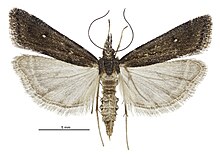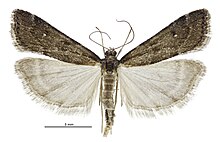Eudonia oculata
| Eudonia oculata | |
|---|---|

| |
| Female | |

| |
| Male | |
| Scientific classification | |
| Domain: | Eukaryota |
| Kingdom: | Animalia |
| Phylum: | Arthropoda |
| Class: | Insecta |
| Order: | Lepidoptera |
| Family: | Crambidae |
| Genus: | Eudonia |
| Species: | E. oculata |
| Binomial name | |
| Eudonia oculata | |
| Synonyms[2] | |
| |
Eudonia oculata is a moth in the family Crambidae.[3] It was described by Alfred Philpott in 1927. This species is endemic to New Zealand and is said to be found only in the South Island, however specimens have also been observed in the lower parts of the North Island and at Chatham Island. This species inhabits grass or shrub land as well as lowland to alpine tussock habitat. Adults are commonly on the wing from November until April and are attracted to light.
Taxonomy
This species was first described by Alfred Philpott in 1927 and originally named Scoparia oculata.[4] George Hudson discussed and illustrated this species in 1939 in his book A supplement to the butterflies and moths of New Zealand under this name.[5] In 1988 John S. Dugdale placed this species in the genus Eudonia.[2] The female holotype specimen, collected in Nelson, is held at the New Zealand Arthropod Collection.[2]
Description

Philpott described this species as follows:
♂ ♀. 19–22 mm.. Head and palpi brown mixed with white. Antennae brown, in male minutely ciliated. Thorax purplish-brown. Abdomen ochreous-grey. Legs ochreous-white, spurs brown. Forewings moderate, costa almost straight, apex rectangular, termen hardly rounded, oblique; dull purplish-brown; markings usually absent, except reniform which is blackish, and obscurely X-shaped, the lower half being filled with white; in some specimens the veins are faintly outlined in black and there is an obscure subterminal line; fringes greyish-brown with a darker basal line. Hindwings fuscous-grey; fringes greyish-white with brownish basal line.[4]
This species is similar in appearance to Scoparia parca but can be distinguished as "the fore-wings are slightly narrower without sinuation in termen, slatey-grey strongly tinged with purple; all the markings are usually absent, except the reniform which is blackish, with the lower half white centred; there is no paler terminal area."[5]
Distribution
This species is endemic to New Zealand.[1] This species is said to be only found in the South Island although specimens have been observed in the lower half of the North Island and the Chatham Island.[6][7][8]
Habitat and hosts
This species inhabits lowland to alpine tussock grassland or native grass or shrubland.[9][6] The larval host plants of this species are likely moss or herbaceous swards.[7] A report in 2021 indicated that the larval host of this species is moss.[9]
Behaviour
Adults are commonly on the wing from November to April.[5] They are attracted to light.[10]
References
- ^ a b "Eudonia oculata (Philpott, 1927)". www.nzor.org.nz. Landcare Research New Zealand Ltd. Retrieved 26 January 2018.
- ^ a b c Dugdale , J. S. (23 September 1988). "Lepidoptera - annotated catalogue, and keys to family-group taxa". Fauna of New Zealand. 14. Department of Scientific and Industrial Research: 157. doi:10.7931/J2/FNZ.14. ISSN 0111-5383. Wikidata Q45083134.
- ^ Gordon, Dennis P., ed. (2010). New Zealand inventory of biodiversity: Kingdom animalia: chaetognatha, ecdysozoa, ichnofossils. Vol. 2. p. 458. ISBN 978-1-877257-93-3. OCLC 973607714. OL 25288394M. Wikidata Q45922947.
- ^ a b Alfred Philpott (15 August 1927). "Notes and Descriptions of New Zealand Lepidoptera". Transactions and Proceedings of the New Zealand Institute. 58: 82–83. ISSN 1176-6158. Wikidata Q107580217.
 This article incorporates text from this source, which is in the public domain.
This article incorporates text from this source, which is in the public domain.
- ^ a b c George Vernon Hudson (1939), A supplement to the butterflies and moths of New Zealand, Illustrator: George Hudson, Wellington: Ferguson and Osborn Limited, p. 427, OCLC 9742724, Wikidata Q109420935
 This article incorporates text from this source, which is in the public domain.
This article incorporates text from this source, which is in the public domain.
- ^ a b B. I. P. Barratt; B. H. Patrick (January 1987). "Insects of snow tussock grassland on the East Otago Plateau". New Zealand Entomologist. 10 (1): 94. doi:10.1080/00779962.1987.9722513. ISSN 0077-9962. Wikidata Q54576207.
- ^ a b Thorsen, M. J. (5 December 2019). "OceanaGold – Deepdell North III: Summary of Ecological Impacts and Remediation" (PDF). waitaki.govt.nz. Retrieved 29 December 2024.
- ^ "Eudonia oculata". iNaturalist. Retrieved 2024-12-29.
- ^ a b "New Zealand Aluminium Smelters Limited. NZAS Closure Preliminary Study. Environmental Study Report – Ecology" (PDF). murihikuregen.org.nz. July 2021. Retrieved 24 December 2024.
- ^ B. H. Patrick (January 1989). "Survey of Lepidoptera at Tara Hills Research Station" (PDF). New Zealand Entomologist. 12 (1): 42–48. doi:10.1080/00779962.1989.9722562. ISSN 0077-9962. Wikidata Q105740636. Archived from the original (PDF) on 9 February 2013.
